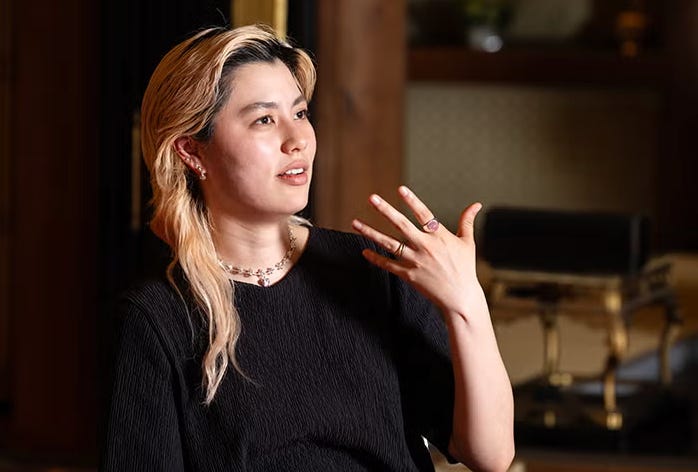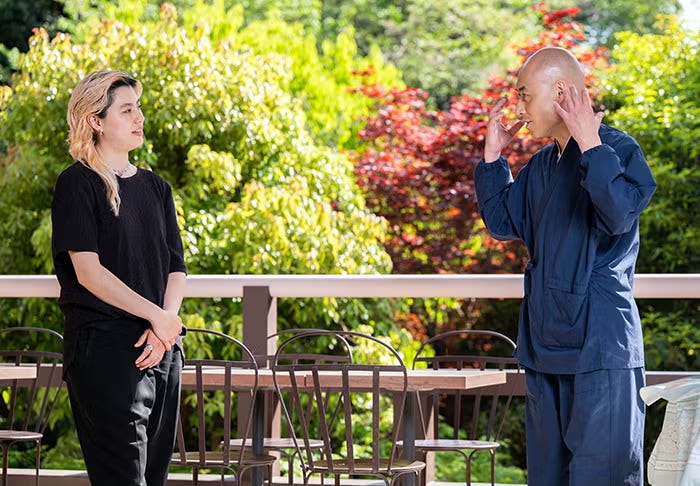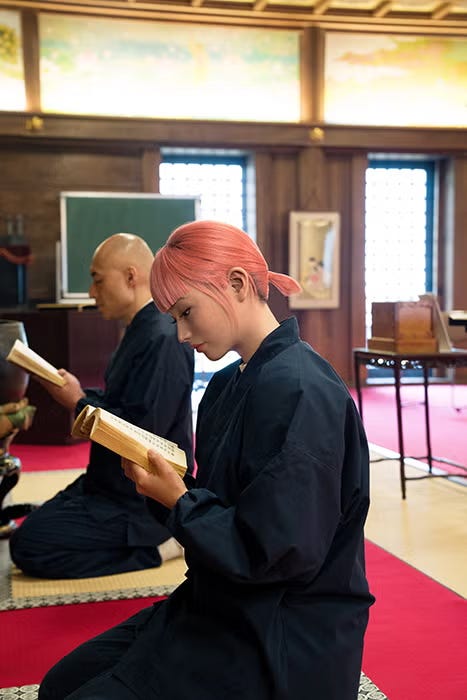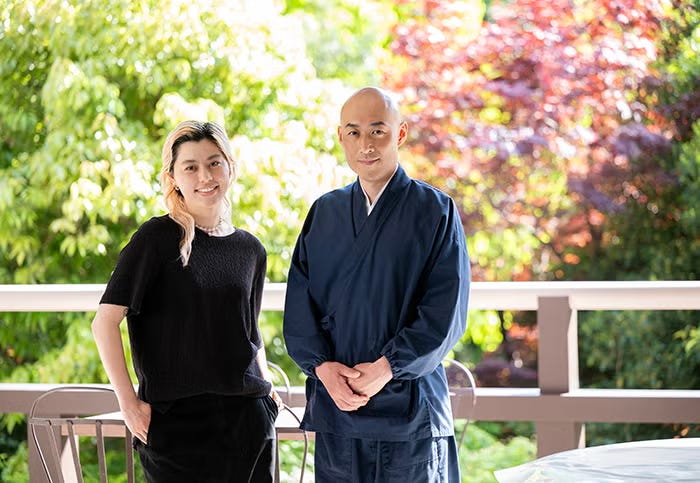Interbeing in the Age of Social Media: Virtual Human imma and the New Threads of Connection 〈3/3〉
Dialogue|Sara Giusto × Shoukei Matsumoto
Episode 5: The Power of Belief and Storytelling
The Power of Belief Shapes the World
Shoukei:
That very “attitude of believing oneself to be number one” is, in fact, what makes us human. With the emergence of AI, such human-centered thinking will inevitably evolve.
I’m currently exploring what form Buddhism should take in this new era. This may apply not only to Buddhism but to Eastern thought as a whole—the idea that “one’s way of seeing creates the world” is deeply connected to what you said earlier, Sara: that “what can be believed becomes truth.” The notion that to change the world, you must first change yourself—that’s a widely recognized truth. For example, someone extremely trusting might see the world as a place full of goodwill, while someone cynical may perceive it as filled with enemies.
A person who constantly judges others—calling this one a success, that one a failure—will, upon failing themselves, fear that the entire world will brand them a failure. This is what we mean by “our perception creates the world.”
But even the very concept of “the world” might be an illusion. As Markus Gabriel argues in Why the World Does Not Exist, there is no all-encompassing “world” per se—it’s merely a concept we hold.
So, where do we begin changing things? It has to start from where we stand. This idea of starting from the ground beneath our feet is at the heart of Mahayana Buddhism’s teachings on “dependent origination” and “emptiness.” In more modern terms, we humans are “inter-beings”—we’re shaped by the interaction between our habitat and our habits.
Change your habitat, and your habits change. Change your habits, and you can influence your environment. You choosing to live in Japan, and me choosing to clean every day—these are both parts of that cycle. Rather than getting swept up in grand concepts, we should start by engaging with the relationship between habitat and habit. That, I believe, is a simple and contemporary way to practice Buddhism.
Sara:
In the end, it all comes down to building one piece of work at a time. When I create a virtual human, I approach it as a single, focused piece of art.
The relationship between “the real” and “reality” is fascinating. Just like habitat and habit—even when we watch the same film, it may not resonate with you at all, while it hits me deeply. That subtle difference in how we sense “reality” is what fine-tunes what we come to believe in.
I think we all need to seriously think about what it is we believe. Just like how Greta Thunberg’s speech moved the world, a powerful emotional experience can give birth to a new sense of “reality.” Recently, I went to a concert at the Sphere in Las Vegas, and that was a perfect example of “reality beyond the real.” There was no actual sky, yet I felt one. I was completely immersed. In a traditional film, anything outside the screen is “not real,” but at the Sphere, you're enveloped in 360 degrees of “reality.”
A single Trump speech can change the world. One movie can change a life. Even imma’s visit to Cambodia might trigger a shift in the world. In the end, I think whoever makes people feel reality wins. Those who evoke reality gain, in a sense, the power to shape what we call “real.”
Shoukei:
I don’t think it’s about winning or losing.
Sara:
You're right—it’s not about winning or losing. But when I watched that five-minute speech by the Prime Minister of Bhutan, I was completely captivated. I thought, “I lost!” Now, I just want to go to Bhutan (laughs). Nothing has changed about my physical “reality,” but in just five minutes of storytelling, I was already convinced.
Shoukei:
He created an immersive experience with words alone.
Sara:
The quality of emotional impact isn’t defined by technological advancement alone. Five minutes of a speech by the Bhutanese Prime Minister versus five minutes at the Las Vegas Sphere—it's not about which is superior. What matters is the quality of the storytelling. With virtual humans flooding the world, imma stands out because we focus on storytelling itself.
That’s why, I think, she’s “winning.” Technology is just a tool. What truly moves people is the power of storytelling—storytelling that can make you want to go to Bhutan in five minutes.
Human Prayer and the Virtual
Shoukei:
It’s interesting to compare Shinran with Shakyamuni Buddha. Shakyamuni, being fully awakened, is unshaken by any story. He does not suffer, nor is he moved by the Bhutanese Prime Minister’s speech.
In contrast, Shinran was keenly aware of “his own self who, despite 20 years of earnest practice, still found himself moved by emotions.” When he referred to people as “evildoers,” “fools,” or “ordinary beings,” what he really meant in modern terms was simply “human.” Though the words sound negative, at their core they reflect deep insight into a fundamental human truth: “I know better, but I just can’t stop myself.”
The key lies in self-awareness—realizing, “Ah, I got carried away by emotions again.” That awareness enables us to maintain just the right distance. It gives us the space to sometimes say, “Well, it’s okay to be moved now and then,” and relate more skillfully to ourselves.
Sara:
Because I’m on the “creator side” of imma, I fully understand that even suffering is part of the virtual. The elements of virtual humans don’t feel like something unknown—they’re more like everyday things made visible. That’s why I think virtuality might actually make Buddhist teachings more accessible.
Shoukei:
Creating and animating a virtual human could even become a kind of Buddhist practice. It might help us better understand what stirs the heart, what pulls at our emotions.
Sara:
But to do that, I think we really need to return to the body. Unless we’re in a healthy state of mind—through practices like meditation—I don’t think we can engage in that kind of deep work. Lately, I’ve been pulled in too many directions and have found it hard to focus on anything. I keep chasing after too much. But the other day, when I chanted sutras with you here at the temple, I felt peace for the first time in a while.
Shoukei:
Please come back to the temple anytime to reclaim your animal nature (laughs).
Sara:
When we talk about what’s real and what’s not, religion tends to be placed on the “not real” side—in the spiritual realm. But I think the act of praying is truly important for humans, even without religion. It doesn’t feel right to just lump it in with “woo-woo” stuff. In fact, I think what we humans are doing now is, in a way, more post-human—more removed from our humanity.
Shoukei:
Prayer is an act particularly characteristic of us as an animal species.
Sara:
No matter who you are, I think prayer can bring a sense of peace. In whatever form it takes—that’s perfectly fine. I often pray when I visit shrines.
Shoukei:
Humans really are a species that prays. Absolutely.
Sara:
In that sense, I think humans are a virtual species. If we consider all the thoughts happening in our brains as “virtual,” then even the act of praying is a kind of virtual experience.
That’s why I’m so drawn to Buddhism.
Shoukei:
There it is—Sara’s Buddhist declaration at the very end (laughs).
(Originally published in Japanese on WEB Sanga Japan)






